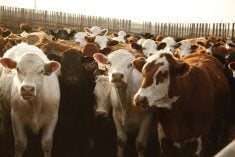During a tour of China last April, a group of southern Alberta farmers had an opportunity to visit a feedlot and slaughter plant.
The group of 33 declined, fearing the consequences for their neighbours in feedlot alley if they should come in contact with foot-and-mouth disease.
What happened upon their return to Canada shocked and dismayed them.
“We came off the plane and we expected a foot bath,” said John Zeinstra of Iron Springs, Alta. Landing in Vancouver, they were told Canada Customs staff was too busy. The group insisted on a foot bath and a staff person eventually arrived with a vat of disinfectant.
Read Also

Growth plates are instrumental in shaping a horse’s life
Young horse training plans and workloads must match their skeletal development. Failing to plan around growth plates can create lifelong physical problems.
Two weeks later, Zeinstra had visitors from the Netherlands who told him they travelled to Chicago, Toronto and Calgary and were not checked.
“It is absolutely inadequate what is happening on the prevention side,” said Zeinstra.
With reports of foot-and-mouth disease common throughout western Great Britain and Asia, Zeinstra was appalled that Canadian officials did not take the situation more seriously.
A veterinarian from the Canadian Food Inspection Agency agreed there were frequent reports about the lack of inspections at busy ports of entry like Toronto and Vancouver.
“There is no defence for it,” said Tom Steele at the recent meeting of the Canadian Federation of Agriculture in Calgary.
“There are100 stories of people who have gone through and physically never got checked.”
Surveillance and physical inspections of travellers and their baggage is Canada’s first line of defence against foreign animal diseases entering the country. During the early days of the British epidemic, meetings were held with Canada Customs officials at “a high level” to take disease surveillance seriously.
In the past, agriculture has been a low priority for Canada Customs because it is also responsible for checking immigrants, drugs and other contraband.
“At one point agricultural products were the top priority over drugs and illegally smuggled products,” said Steele.
“I am not na•ve enough to believe that we have managed to maintain that level of concern. We don’t have enough inspectors to check every person.”
The CFIA has a detailed emergency measures plan to keep contagious animal diseases out of the country
Recently, a world-class animal disease laboratory was opened in Winnipeg.
The national centre for foreign animal disease has a diagnostic lab for investigating and maintaining surveillance on potentially serious diseases.
The centre is headed by English veterinarian Paul Kitching, whose most recent job was foot-and-mouth surveillance in Great Britain.
Health Canada officials also work at the Winnipeg centre to share information on possible threats to human health.
Canada’s main goal is to prevent the entry of disease. If there is an episode, the federal government works with the provinces, industry and private firms to eradicate the disease.
A disease surveillance unit provides daily updates to inform a wide body of people including Canada Customs, the provinces and local veterinarians.
Following guidelines developed in 1976, Canada, the United States and Mexico developed task forces to deal with disease outbreaks. There is a North American vaccine bank and procedures have been drawn up to deal with such diseases as foot-and-mouth. The foot-and-mouth manual was updated last summer.
Each province has its own response team with the exception of combined teams for the Maritimes, Saskatchewan and Manitoba.
The federal government also has an edible residue policy. Surveillance has been increased to ensure international garbage does not find its way to farms that feed livestock swill. There are 20 Canadian farms licensed to feed swill.
If an outbreak of disease does occur, federal veterinarians have tools to take charge. They include investigations, quarantines, pre-emptive slaughter of healthy animals at risk, slaughter of infected animals, vaccines, carcass treatment and decontamination of infected premises.
If a suspect case occurs, the vets visit the farm and send samples to the national disease centre in Winnipeg. If samples test positive for a high risk disease, vets have the authority to quarantine and do trace-outs and trace-ins.
This team could be mobilized within 24 hours. Within that time they have 24 hours to report to the international centre for epizootic diseases, producer groups, RCMP, military, CFIA staff and media.
If the disease is confirmed, a control zone is set up to restrict animal and people movement. A control area would also be established, as steps are taken to stop the disease.
If needed, vaccines would be administered to surrounding farms.
Once the disease is eradicated, the minister of agriculture can lift controls as recommended by the national disease response team.
In addition, the CFIA wants to compile a database of livestock operations that would provide information on animal populations, farm ownership and farm location in the event notification is needed.
Ultimately the CFIA hopes to see all major livestock groups identified. Since the Canadian Cattle Identification Agency implemented a traceback system for cattle, two cases of disease have been detected and quickly traced back to the source.
“It will give up that information in a matter of minutes,” Steele said.
Details of the incidents cannot be disclosed.















